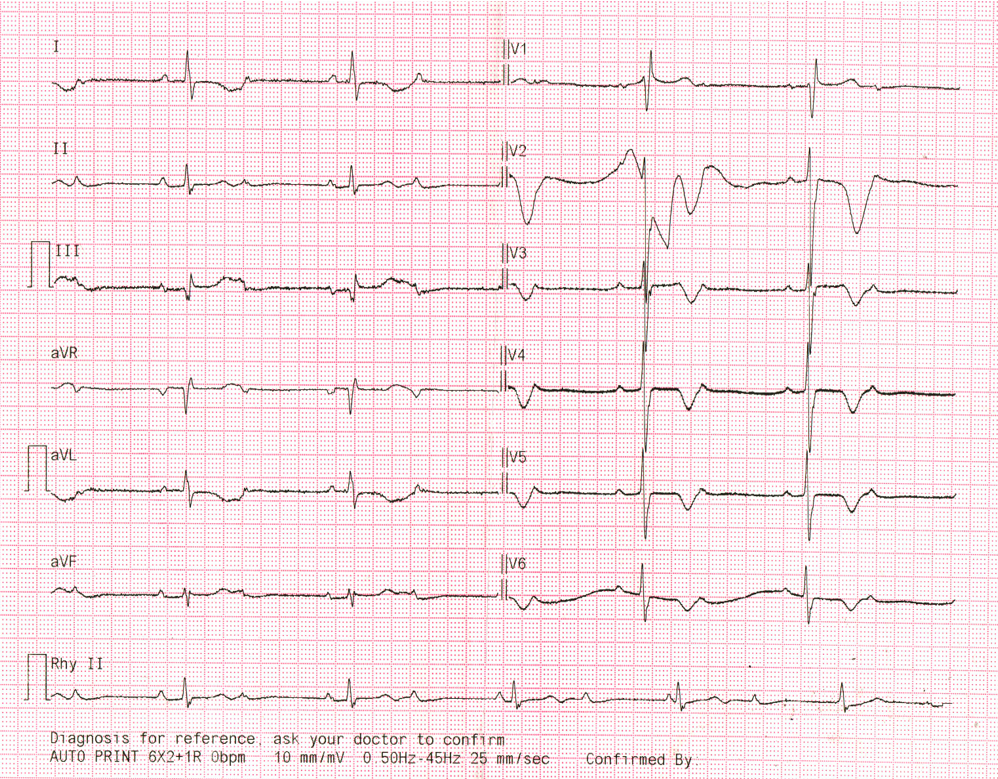CASE20250515_001
Percutaneous Closure of an Iatrogenic Right Ventricular Perforation with Duct Occluder After Left Main Primary PCI
By RAJESHWARI LINGALA
Presenter
RAJESHWARI LINGALA
Authors
RAJESHWARI LINGALA1
Affiliation
Jipmer, Puducherry , India1,
View Study Report
CASE20250515_001
Other Interventions - Other Interventions
Percutaneous Closure of an Iatrogenic Right Ventricular Perforation with Duct Occluder After Left Main Primary PCI
RAJESHWARI LINGALA1
Jipmer, Puducherry , India1,
Clinical Information
Relevant Clinical History and Physical Exam
A 70-year-old female, with no known past medical history, presented to EMS following an episode of syncope accompanied by giddiness. She denied any associated chest pain. On arrival, her hemodynamic status was noted as borderline with a blood pressure of 82/50 and Heart rate of 38 beats per minute. She had mild tachypnea and spo2 was 94% room air.
 RCA injection.mp4
RCA injection.mp4
 LAO cranial LM Ostial lesion.mp4
LAO cranial LM Ostial lesion.mp4
 LAO caudal.mp4
LAO caudal.mp4
Relevant Test Results Prior to Catheterization
High sensitive Trop I > 2000 ng/L
ECG showed Complete heart block with narrow ventricular escape at a rate of 40/min. Echo- Fair LV functionLabs- WNL Hemoglobin- 12.5 mg/dlCreatinine 1.16 mg/dlLDL - 91 mg/dl

ECG showed Complete heart block with narrow ventricular escape at a rate of 40/min. Echo- Fair LV functionLabs- WNL Hemoglobin- 12.5 mg/dlCreatinine 1.16 mg/dlLDL - 91 mg/dl

Relevant Catheterization Findings
PCI to Ostial LM- LAD (Provisional) was done - with Biomime stent 4x19mmPost dilation- 4.5mm @ 18 atmGood results. TIMI-III FlowNo imaging done.ECG- Sinus rhythm in next 6 hours
 stent deployed.mp4
stent deployed.mp4
 post dilation.mp4
post dilation.mp4
 Final TIMI III flow.mp4
Final TIMI III flow.mp4
Interventional Management
Procedural Step
Following an initial procedure, the patient's jugular temporary pacemaker was removed on Day 1 at 6:00 PM. However, by 3:00 AM on Day 2, the patient developed signs of shock. An echocardiogram revealed cardiac tamponade, necessitating pericardiocentesis. A pigtail catheter was placed, and the femoral TPI remained in situ.On Day 3, the patient's cardiac rhythm converted to sinus rhythm, and the femoral TPI was removed. The patient remained without a drain for the subsequent two days and was eventually transferred to the ward. Subsequently, the pigtail catheter was removed. Unfortunately, the patient again developed tamponade, requiring a second pericardiocentesis under fluoroscopic guidance. Following this second intervention, the patient's hemodynamic status continued to deteriorate.She sustained bradycardia and cardiac arrest, and ROSC was achieved after 2 cycles of CPR. She was taken up for RV rent closure, which occurred due to pigtail catheter insertion.
Steps of procedure - 2nd access-subxiphoid - drainTeflon wire through pigtailRemoval of pigtailImmediate insertion of 6F Femoral 11cm sheath with dilator OTWConfirmation of sheath in RV cavity with contrast injection/PressureDevice preparationDeployment of the LifeTech
 Teflon through pigtail.mp4
Teflon through pigtail.mp4
 sheath in RV cavity.mp4
sheath in RV cavity.mp4
 Device deployment.mp4
Device deployment.mp4
Steps of procedure - 2nd access-subxiphoid - drainTeflon wire through pigtailRemoval of pigtailImmediate insertion of 6F Femoral 11cm sheath with dilator OTWConfirmation of sheath in RV cavity with contrast injection/PressureDevice preparationDeployment of the LifeTech
Case Summary
Patient improved, hemodynamically stable and discharged.
Management options for RV rent closure include catheter-based intervention or surgical closure. Catheter based Intervention 1. Devices (Off label )- ADO I - ADO II 2. Vascular closure devices Collagen plug based Suture based devices
Iatrogenic perforation of RV is a dreaded complication of pericardiocentesis. (2%)Duct occluder (ADO1) represents an effective, minimally invasive, readily available on-shelf treatment.
Management options for RV rent closure include catheter-based intervention or surgical closure. Catheter based Intervention 1. Devices (Off label )- ADO I - ADO II 2. Vascular closure devices Collagen plug based Suture based devices
Iatrogenic perforation of RV is a dreaded complication of pericardiocentesis. (2%)Duct occluder (ADO1) represents an effective, minimally invasive, readily available on-shelf treatment.
